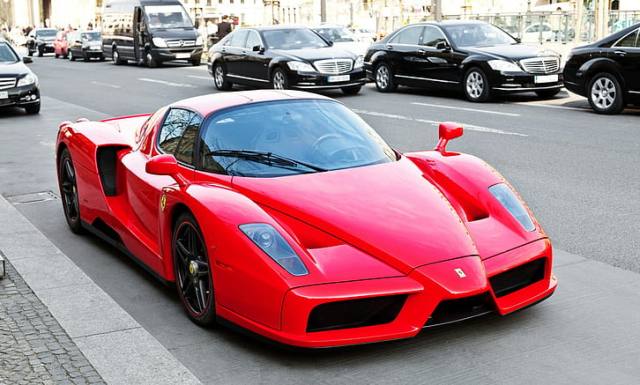Ferrari Enzo, Ferrari's Fantastic Third Generation Super Sports Car
With a top speed of almost 220 mph and massive acceleration taking the car to 100 mph in just 6.3 seconds, the Ferrari Enzo is the Italian company's road going masterpiece. By comparison, the F50, no mean performer, took 8.0 seconds, and that's a very big difference.
Built with Grand Prix racing experience
Like the F40 and F50 before it, the Enzo was designed to take advantage of the know-how of Ferrari's Grand Prix racers. The styling, too, was designed to make it look like a two-seater racer, with the two front air intakes and raised central nose mimicking the high nose and wings of the F1 cars.
To look like a racer
Air from the radiators is taken out through outlets in the hood, and there are long, narrow headlamp covers in the fenders a quite unique front end. Pinifarina designed the car with sharply curved coach roof and typical fastback with a big window to create the smooth profile. In dark colors, it all looks a bit Darth Vader. But then, there's only one self-respecting color for an Enzo and that's Ferrari red.
The back end has an upwardly sloping under tray, and owing to the two diffusers and other changes, lacks the high spoiler of the F40 and F50. It is no longer needed thanks to the improved aerodynamics, again coming from F1 experience.
With such a powerful engine and brakes, big air intakes and outlets are essential; there is a long air outlet behind each front wheel, and then the rear fenders flare out to give plenty of room for large air intakes to the engine compartment.
Carbon fiber and honeycomb
Interestingly, the structure consists of a carbon fiber tub reinforced with an aluminum honeycomb, instead of the straight carbon fiber tub used by most people. McLaren also used aluminum honeycomb, which is excellent for making rigid and lightweight flat panels like the floor, on the F1.
V-12 with variable valve timing
To drive any car at 220 mph, you need a lot of power, and the heart of the Enzo is a 6.0-liter V-12 producing 660 bhp at 7,800 rpm really, to use that power you need to be on a track.
To give reasonable performance at low speeds, the valve timing is varied according to speed, while the intake manifold also has variable length achieved with flaps. The maximum torque of 485 lb-ft (657 Nm) is produced at 5,500 rpm, not that high for an engine producing 110 bhp per liter.
To transmit all this power is a twin-plate clutch and six-speed gearbox, which is controlled by paddles on the steering wheel. Very similar to the system on Schumacher's Grand Prix car, the system is claimed to shift gear in 150 milliseconds.
Sport and Race modes for semi-auto box
Ferrari doesn't offer Normal and Sport modes; instead it offers Sport and Race modes! I mean, who would buy an Enzo and want a 'city mode'. One neat feature is that in Race mode, you can control the engine speed at which the car takes off. When starting from rest, you just set put a foot on the brake pedal and then set the engine to the revs you want, and release the brake and off you go, as fast as you like. Nice touch that.
Inboard front suspension is fitted, and at the rear the suspension is mounted on a sub-frame. These wishbone systems are designed to reduce dive under braking and squat under acceleration and both are needed owing to the power available.
Variable damping
The dampers have variable valves, controlled according to conditions automatically. These are linked up to the main electronic control system which gets information from four sensors, and adjusts the settings according to what the car, engine and brakes are doing.
Therefore the damper settings are altered according to whether the car is accelerating, braking or cornering.
Big Brembo brakes complete the basics of the car, and these are under control of an ABS system. To reduce weight and improve braking, ceramic discs are used. Needless to say, the tires are quite special Bridgestone Potenza Scudeiras on big wheels. The wheels are 9 inches wide at the front, and 13 inches wide at the rear; they're all 19 inch diameter, and the tires are 245/35 front and 345/35 rear.
A sensational vehicle, by any standards, faster than the Porsche Carrera GT, and most other exotic supercars, but not quite as fast as the McLaren F1. The Enzo is also very wide, with tracks 2 inches wider than on the F50, which with the massive engine and transmission led to an increase in weight 3,009 lb (1,365 kg), compared with 2,712 lb for the F50; 2,504 lb for the McLaren F1, and 2,820 lb for the Zonda which has a massive 7.3 liter engine.
Not the lightest kid on the block, but a mighty fine motor nevertheless. Exclusive too; only 349 are being built.

Comments
Post a Comment